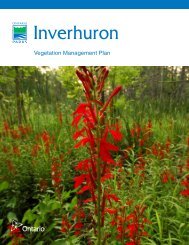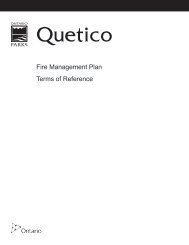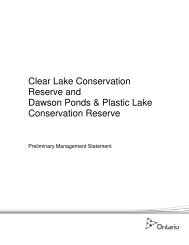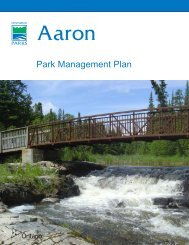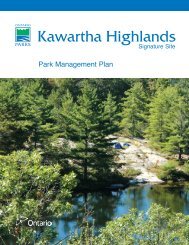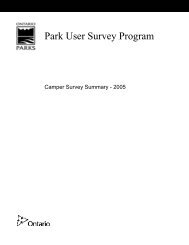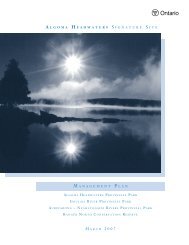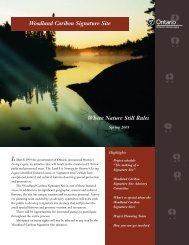Sandbanks Draft Veg Mgmt Plan - Ontario Parks
Sandbanks Draft Veg Mgmt Plan - Ontario Parks
Sandbanks Draft Veg Mgmt Plan - Ontario Parks
Create successful ePaper yourself
Turn your PDF publications into a flip-book with our unique Google optimized e-Paper software.
IMPLEMENTATION SCHEDULE G – Restoration Implementation <strong>Plan</strong><br />
• Vary size and orientation to approximate natural landscapes – small pits and mounds<br />
should be 3 – 5 m is diameter and 1 m deep, about 250 of each per hectare<br />
• Create several larger ponds per hectare – these will act as deep permanent pools<br />
• Leave a 5-10 m buffer near forest edge so roots of established trees are not<br />
disturbed<br />
• An earth-mover can work approximately 6 hectares/day, at a rate of $500/day<br />
• Seed or plant as necessary or possible – see seeding & planting methods<br />
Hedgerows<br />
Hedgerows should be established around the perimeter of the restoration sites after the land<br />
has been treated. These will help to create linkages in the landscape, act as a barrier to the<br />
spread of invasive seeds, and improve microclimate conditions. This method is described<br />
further in the North-South Environmental report, including appropriate species.<br />
• Create hedgerows composed of native species of the area<br />
• Use fast-growing tree species and caliper stock - will function as a hedgerow and<br />
attain a height out of the reach of deer quicker<br />
• Create 3 or 4 staggered rows of trees spaced approximately 3 m apart to provide a<br />
barrier (the trees within each row should be placed every 1.5 m apart)<br />
• <strong>Plan</strong>t container/potted stock shrubs between each of the rows of trees, spaced<br />
approximately 1 m apart<br />
• <strong>Plan</strong>t the trees early in the spring (April/May) following the planting method below<br />
• Monitor survival of planted stock to determine appropriateness of species<br />
• Use poplars, White Ash, Chokecherry, and sumac in areas close to salted roads<br />
Detailed <strong>Plan</strong>ting Methods<br />
<strong>Plan</strong>ting trees and shrubs on the sites will speed up the process of creating a continuous<br />
canopy by initiating succession and acting as a seed source for continued regeneration.<br />
<strong>Plan</strong>t Selection<br />
• Select trees and shrubs that:<br />
• Grow well in the open and have some deer resistance (e.g. oaks)<br />
• Sucker profusely (e.g. Trembling Aspen and Balsam Poplar)<br />
• Have heavy annual seed crop<br />
• Disperse seeds by birds (e.g. cherries and dogwoods) and wind (e.g. White Birch)<br />
• Initially plant pioneer species that will help to condition the soil and provide shade for<br />
shade tolerant species to grow later. Some climax species can also be mixed in or<br />
added in subsequent years.<br />
• Obtain the plant material from a local supplier (Appendix C).<br />
• Bareroot or container/potted stock of plants can be purchased. The advantages and<br />
disadvantages of each are outlined below.<br />
Bareroot<br />
Cheaper, easy to transport large quantities<br />
Roots must be kept moist at all times<br />
Must be planted when dormant in spring and<br />
Container/potted stock<br />
More expensive, bulky and heavy to<br />
transport<br />
Can be stored easily<br />
More flexible in planting times<br />
<strong>Sandbanks</strong> <strong>Veg</strong>etation Management <strong>Plan</strong> A-26<br />
<strong>Ontario</strong> <strong>Parks</strong>, SE Zone<br />
2009





